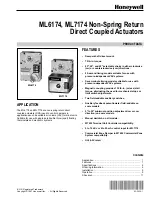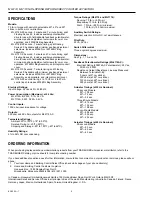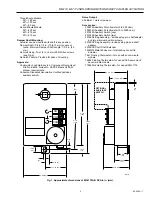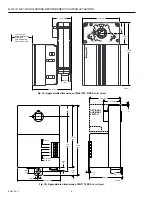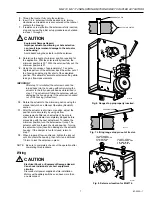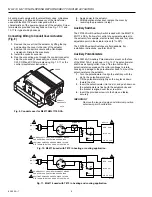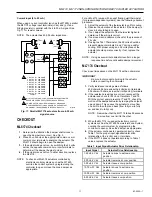
ML6174, ML7174 NON-SPRING RETURN DIRECT COUPLED ACTUATORS
63-2534—1
7
5.
Thread the locknut fully onto the setscrew.
6.
Insert 1/4 in. setscrew into the desired hole, turning
clockwise until resistance is encountered or the locknut
contacts the housing.
7.
If resistance is met before the setscrew is fully inserted,
stop and review the initial setup procedures as detailed
in steps 1 through 3.
CAUTION
Equipment Damage Hazard.
Improper actuator positioning or hole selection
can result in permanent damage to the actuator
and housing.
Avoid backdriving the actuator with the setscrew.
8.
Determine the angle of minimum position required for
the application. With the setscrew fully inserted, the
minimum position is 30
°
. With the setscrew fully out, the
minimum position is 0
°
.
9.
Using the conversion of approximately 1.7 angular
degrees per turn of the setscrew, back the screw out of
the housing and stop slightly short of the calculated
position. This allows for accurate setscrew setting while
taking air flow measurements.
IMPORTANT
After step 10 is initiated, the setscrew cannot be
turned back into the housing without returning the
actuator to the fully open position as determined in
step 1. The actuator will follow the setscrew without
damaging the housing only if the setscrew is backed
out of the housing (turned ccw).
10.
Rotate the actuator to the minimum position using the
manual declutch, see Manual Operation (Declutch)
section.
11.
After the actuator is at minimum position, adjust the
position more accurately by using air flow
measurements. After each adjustment, be sure to
check that the actuator is completely stopped before
proceeding with the next adjustment. To reduce the
minimum position, turn the setscrew out (ccw). The
actuator will drive toward the closed position. Turning
the setscrew in (cw) results in damage to the actuator
housing. If the damper is too far closed, return to
step 1.
12.
When proper air flow is achieved, tighten the locknut
until it contacts the housing, then turn it an additional
1/8 turn to lock the setscrew in place.
NOTE:
Be sure to completely check out the operation after
completing this procedure.
Wiring
CAUTION
Electrical Shock or Equipment Damage Hazard.
Can shock individuals or short equipment
circuitry.
Disconnect all power supplies before installation.
Motors with auxiliary switches can have more than
one disconnect.
60
45
45
60
CW
CCW
COM
RANGE STOP PIN
ACTUATOR PLATES
M10246A
Fig. 6. Range stop pin properly inserted.
SCREWDRIVER
M2065
Fig. 7. Lifting range stop pin out of its slot.
M10247
60
45
45
60
THIS SET SCREW
CORRESPONDS WITH
CLOSING IN THE
CW DIRECTION
THIS SET SCREW
CORRESPONDS WITH
CLOSING IN THE
CCW DIRECTION
Fig. 8. Setscrew location for ML6174.

